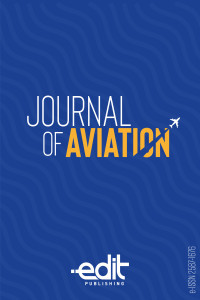Quadrotorlarda Yaw Hareketi için Eşzamanlı Olmayan Başkalaşım Tasarımı
Quadrotorlar askeri ve sivil uygulamalarda sıkça kullanılan insansız hava araçlarıdır. Bu çalışmada quadrotor yaw hareketinin modellenmesi, kontrolü ve değişken geometrisi ile eşzamanlı olmayan başkalaşımı ele alındı. Quadrotor lineer olmayan yapıya sahiptir fakat sistem çeşitli metodlar kullanılarak lineer yapıya dönüştürülmüştür. Lineer ifadeler ise durum uzay modeli yaklaşımı ile ifade edilmiştir. Simlasyonlar durum uzay modeli yaklaşımı kullanılarak Matlab/Simülink programında yapılmıştır. PID kontrolü isesistemi kontrol etmek için kullanılmıştır. Simülasyonda hem başkalaşım olmayan durum hemde başkalaşım durumları simüle edilerek karşılaştırmalar yapılmıştır.
Anahtar Kelimeler:
quadrotor, Başkalaşım, Durum Uzay Modeli, PID, Kontrol
Non Simultaneous Morphing System Design for Yaw Motion in Quadrotors
Quadrotors are unmanned aerial vehicles that are frequently used in military and civilian applications. In this study, the modeling, control and variable geometry of the quadrotor's yaw motion are discussed non simultaneous. Quadrotor has a non-linner structure but the system has been converted to linear structure by using various methods. Linear expressions are expressed by state space model. Simulation was performed in Matlab / Simulink environment using state space model. PID algorithm was used as control system. In the simulations, both without morphing results and morphing results were obtained and compared.
Keywords:
Quadrotor, Morphing, State Space Model, PID, Control,
___
- F. Şal, "Effect of the Simultaneous Variation in Blade Root Chord Length and Blade Taper on Maneuvering Manned Helicopter Control Effort," Avrupa Bilim ve Teknoloji Dergisi, no. 15, pp. 475-482.
- S. Norouzi Ghazbi, Y. Aghli, M. Alimohammadi, and A. A. Akbari, "QUADROTORS UNMANNED AERIAL VEHICLES: A REVIEW," International Journal on Smart Sensing & Intelligent Systems, vol. 9, no. 1, 2016.
- O. Köse and T. Oktay, "Non Simultaneous Morphing System Desing for Quadrotors," Avrupa Bilim ve Teknoloji Dergisi, no. 16, pp. 577-588.
- A. Marks, J. F. Whidborne, and I. Yamamoto, "Control allocation for fault tolerant control of a VTOL octorotor," in Proceedings of 2012 UKACC International Conference on Control, 2012: IEEE, pp. 357-362.
- S. Bouabdallah, "Design and control of quadrotors with application to autonomous flying," Epfl, 2007.
- S. ÇOBAN, H. H. BİLGİÇ, and T. OKTAY, "Designing, Dynamic Modeling and Simulation of ISTECOPTER," Journal of Aviation, vol. 3, no. 1, pp. 38-44, 2019.
- T. Bresciani, "Modelling, identification and control of a quadrotor helicopter," MSc Theses, 2008.
- T. Oktay and O. Kose, "The Effect of Collective Morphing on the Vertical Flight in Quadcopter," in MAS INTERNATIONAL EUROPEAN CONGRESSON MATHEMATICS, ENGINEERING, NATURAL ANDMEDICAL SCIENCES-III, Şanlıurfa, 2019, pp. 1-10.
- T. Oktay and F. Sal, "Combined passive and active helicopter main rotor morphing for helicopter energy save," Journal of the Brazilian Society of Mechanical Sciences and Engineering, vol. 38, no. 6, pp. 1511-1525, 2016.
- T. Oktay and O. Kose, "The Effect of Collective Morphing on the Lateral Flight in Quadcopter," presented at the Umteb 6. Uluslararasi Mesleki ve Teknik Bilimler Kongresi, Iğdır, 2019.
- J. M. Domingue, "Quadrotor Prototype. Uneversidade Tecnica deLisboa," Dissertacio, 2009.
- T. Oktay and O. Kose, "The Effect of Collective Morphing on the Longitudinal Flight in Quadcopter," presented at the MAS INTERNATIONAL EUROPEAN CONGRESSON MATHEMATICS, ENGINEERING, NATURAL ANDMEDICAL SCIENCES-III, Şanlıurfa, 2019.
- O. Kose and T. Oktay, "Dynamic Modeling and Simulation of Quadrotor for Different Flight Conditions," European Journal of Science and Technology, no. 15, pp. 132-142, 2019.
- Yayın Aralığı: Yılda 3 Sayı
- Başlangıç: 2017
- Yayıncı: Vedat Veli ÇAY
Sayıdaki Diğer Makaleler
Oyuk Boşluk Yapısının Kanat Profili Üzerine Etkisi
Hüsamettin Alperen ALABAŞ, Mohammed ALBATRAN, Tayfun ÇELİK, Mustafa LÜLECİ, Ümit Deniz GÖKER
Quadrotorlarda Yaw Hareketi için Eşzamanlı Olmayan Başkalaşım Tasarımı
İnsansız Hava Aracı Kullanımından Doğan Sorumluluk
Mustafa ÖNAL, Sezer ÇOBAN, Ahmet YAPICI, Hasan Hüseyin BİLGİÇ
